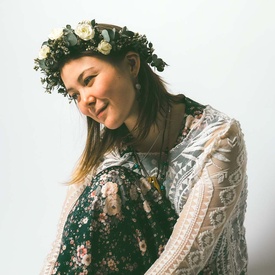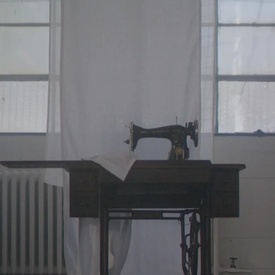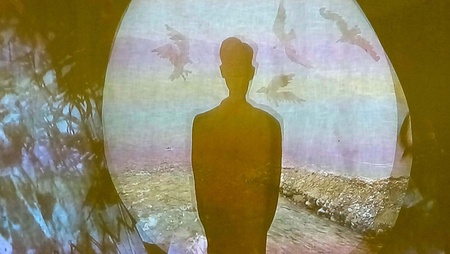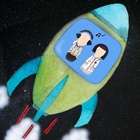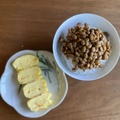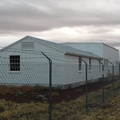Japanese Canadian Annie Sumi is many things: songwriter, ethereal folk artist, and, recently, co-creator of the Kintsugi exhibition at the Japanese Canadian Cultural Centre in Toronto. Providing creative insight inspired by family heirlooms, her work on Kintsugi weaves together the threads of her ancestry with her artistry as a musician.
Ancestry
Sumi originally hails from Ontario, Canada. Second-generation Scottish through her mother’s side, she recalls that she grew close to the songs and traditions that were brought to Canada from her grandparents’ hometown of Glasgow.
“My family that lives in Scotland don’t do them anymore, but we still do it because we have latched onto that part of the culture,” she notes with a laugh.
Sumi is also fourth-generation Japanese through her father, with her ancestors emigrating from Tottori and Hiroshima before World War II. Although she laments over how she was not quite old enough to learn the traditions from her grandmother before her passing, she’s still fond of the Japanese picnics and New Year’s celebrations that she grew up with.
Memories of the Japanese Canadian incarceration are a familiar call to Sumi as well. Recounting a trip with her grandfather to the site of his incarceration – the Rosebery concentration camp in British Columbia – during his youth, Sumi observed the mixed emotions that accompanied her.
“When I went there with him, his stories were really sweet and held all the innocence and wonderment of a child. Then the juxtaposition of that story next to the history of that space and the research we found about that time created such a different feeling.”
Other experiences have likewise shaped Sumi’s understanding and identification as “Nikkei,” but a recent conversation at a symposium for Japanese Canadian artists has led her to explore how she identifies both as a Nikkei and as a human.
“At the symposium, it was interesting because there were so many different opinions about the word ‘Nikkei.’ I feel like I haven’t chewed on that enough yet to really digest what it means to identify as Nikkei. That feels like a good thing to ponder about,” she says.
Being of both Japanese and Scottish ancestry has also shaped how she navigates the facets of her identity. Mentioning that the best way to embrace her “mixed-race-ness” has been to “feel the richness of the cultures that theycome from,” Sumi likewise comments that she claims herself as she is.
“I am Annie,” she expresses, “I am made up of so many parts and so many universes, and experiences, and geographies of this world.”
Artistry

Sumi has released two critically-acclaimed albums – Reflections and In the Unknown – and has since received numerous nominations from the Canadian Folk Music Awards, TIMAs, and CFMAs. In addition to songwriting, Sumi has toured across Canada, the U.S., and Europe. She further cites an adoration for the crowd’s palpable energy when she performs.
Describing her music as “ethereal folk,” much of Sumi’s lyricism is “deeply inspired by spirit and landscape.” In fact, Sumi’s third album, Solastalgia, is both a reflection on relational connections and a conversation starter on the current climate crisis. “We all have that deep connection to nature if we’re open to it – and if it’s open to us,” voices Sumi.
Ancestral influence often bleeds into Sumi’s artistic works as well. Magnetized to Japanese concepts, in particular, Sumi cites concepts such as ma and wabi-sabi as equally delightful and connective to her ancestry. Kintsugi, the art of repairing broken pottery with gold and an embrace of the imperfect, is an especially meaningful concept to Sumi. Although woven throughout her personal philosophy, Kintsugi is now also the name of her installation with Brian Kobayakawa at the Japanese Canadian Cultural Centre (JCCC) in Toronto.
The mixed media installation is largely sound-based, with music connected through an old treadle-foot sewing machine that once belonged to Kobayakawa’s grandmother.
The sewing machine is an especially moving piece, according to Sumi. Because all items belonging to Japanese Canadians were auctioned off during their incarceration, families had little or nothing to return to after the war. Remarkably, the sewing machine was one of the few verifiable items that could be traced back through documentation as a family possession both before and after camp.
“Somehow the sewing machine made it through to be with Brian’s family after the internment,” Sumi comments.
The sewing machine has since been modified to connect to a larger sound system for the Kintsugi installation. Pressing the foot of the machine activates magnetic sensors that pick up on a frequency which then runs through a computer. The final result is a coordinated display of projected film and music.
The lyricism and poetics are of Sumi and Kobayakawa’s handiwork. Inspired by their families' experiences during incarceration and their own multiracial identities, Sumi voices that "The piece really centers around finding our place among the multitude of ancestral stories – the ones that have been told to us, but also the ones that haven't been told to us."
Closing
Today, Sumi resides on a small farm in Ithaca, New York – a place where she spends her time relishing the local flora and fauna. In addition to tending to her garden and livestock, Sumi reports that she enjoys walks to waterfalls and trips to the Finger Lakes region.
Connecting with local Japanese American communities has been of interest to Sumi as well. With a love for the Nikkei community, Sumi notes that kinship amongst diasporic communities is something worth craving. “To have an ease of reflection about this shared experience has been really beautiful to me,” she says.
The future likewise holds exciting and promising prospects for Sumi. Working with friends in Western Canada for a poetry project and collaborating with composer Kate Nishimura are both within the realm of possibility for the singer-songwriter in the near future.
Still, the philosophy of kintsugi remains ever-appreciated by Sumi in all her works – past, present, and future – as she continues to explore its many applications.
“The wisdom of kintsugi offers so much potential,” she voices in her closing marks, “For healing, for appreciation, and for acceptance of ourselves in all of our brokenness.”
© 2022 Kyra Karatsu



